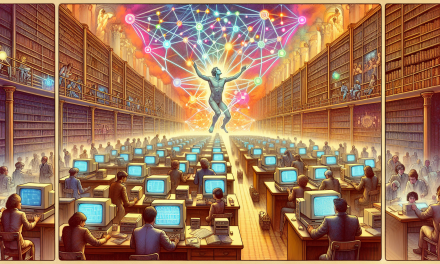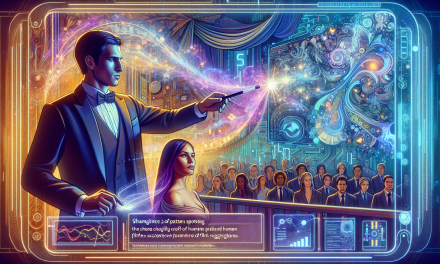
Picture this: you’re staring at a puzzle that seems impossible. Maybe it’s a brain teaser from your childhood, or perhaps it’s a stubborn piece of code that refuses to work. Your mind starts working through the problem systematically – breaking it apart, looking for patterns, testing different approaches. Without realising it, you’re thinking like both a mathematician and a programmer, thanks to lessons that began decades ago in the pages of Scientific American magazine.
Meet Martin Gardner, a man who never earned a mathematics degree but became one of the most influential mathematical educators of the 20th century. Through his legendary “Mathematical Games” column, which ran for 25 years starting in 1956, Gardner introduced millions of readers to the joy of mathematical thinking. More importantly for our digital age, he unknowingly laid the groundwork for what we now call computational thinking – the very skills that make someone a natural coder.
The Magic Behind Mathematical Games

Gardner had a superpower that every great teacher possesses: he could make the complex feel simple and the abstract feel tangible. His monthly column wasn’t filled with intimidating equations or academic jargon. Instead, he presented puzzles you could solve with coins, paper, and pure thinking. One month might feature a challenge about folding a piece of paper to create perfect geometric shapes. The next might explore how to arrange dominoes on a chessboard with two corners removed.
What made Gardner’s approach revolutionary wasn’t just the accessibility – it was how these “games” secretly taught profound mathematical concepts. When you worked through one of his hexaflexagon puzzles (those fascinating folded paper structures that reveal hidden faces), you were actually exploring topology and spatial reasoning. When you tackled his logic puzzles about knights and knaves on imaginary islands, you were learning the foundations of Boolean logic that would later become essential in programming.
Think of Gardner’s puzzles as the ultimate “unplugged” computer science activities, decades before anyone coined that term. He was teaching algorithmic thinking without a single line of code, proving that the most important programming concepts exist in the world around us, waiting to be discovered through play and curiosity.
From Puzzle to Program: The Hidden Connections
Let’s take a closer look at one of Gardner’s famous puzzles to see how mathematical games translate into coding skills. Consider the “15-puzzle” – you know, that sliding tile game where you try to arrange numbered squares in order by sliding them into an empty space. Gardner explored this puzzle in depth, revealing fascinating mathematical properties about which starting positions could actually be solved.
When you work through this puzzle by hand, you’re developing the exact same thinking patterns that make someone a skilled debugger. You learn to recognise patterns (“If this tile is here, then that one must go there first”). You develop systematic approaches (“Let me try to get the top row sorted first, then work downward”). Most importantly, you learn to think several moves ahead and recognise when you’ve reached a dead end that requires backtracking.
These aren’t just puzzle-solving skills – they’re debugging skills. Every programmer knows the frustration of code that almost works but produces the wrong result. The techniques Gardner’s readers learned through mathematical games – careful observation, systematic testing, pattern recognition, and logical reasoning – are precisely what you need when tracking down elusive bugs in your programs.
The Art of Breaking Down Problems
One of Gardner’s greatest gifts was showing readers how to tackle seemingly impossible problems by breaking them into smaller, manageable pieces. This approach, which computer scientists call “decomposition,” appeared throughout his work, though he never used such fancy terminology.
Take his exploration of the “Tower of Hanoi” puzzle, where you move disks of different sizes between three posts following simple rules. Gardner didn’t just present the puzzle – he walked readers through the thinking process. How do you move a tower of five disks? First, figure out how to move a tower of four disks to expose the largest one. How do you move four disks? By first moving three disks. And so on, breaking the problem down until you reach something simple enough to solve directly.
This recursive thinking – solving complex problems by breaking them into simpler versions of the same problem – is fundamental to both mathematics and programming. Gardner’s readers were learning to think recursively long before they encountered their first programming language, building mental models that would serve them well in any computational challenge.
The beauty of Gardner’s approach was that he made this problem-solving methodology feel natural and even playful. Readers weren’t memorising algorithms – they were discovering the joy of systematic thinking. They learned that the most elegant solutions often come from finding the right way to break down a problem, not from brute force or lucky guesses.
Pattern Recognition: The Programmer’s Secret Weapon

Gardner had an uncanny ability to reveal hidden patterns in everyday situations, and this skill transferred beautifully to computational thinking. His column frequently explored sequences, symmetries, and mathematical relationships that trained readers to spot patterns – an essential programming skill.
Consider his work with magic squares, where numbers are arranged so that every row, column, and diagonal adds up to the same sum. Working with these squares teaches you to see relationships between data points, to recognise when something doesn’t fit the expected pattern, and to systematically verify that your solution works. These are exactly the skills you need when working with arrays in programming, or when designing algorithms that process structured data.
Gardner’s readers learned to ask the right questions: “What’s the rule here?” “Does this pattern hold in all cases?” “What happens if I change one element?” These questions form the heart of algorithmic thinking. A programmer debugging a loop asks the same questions – looking for patterns in how the code behaves, checking edge cases, and verifying that the logic holds under different conditions.
The pattern recognition skills developed through mathematical games extend far beyond coding. They help in data analysis, in recognising user interface design patterns, and in understanding the underlying structures that make complex systems work. Gardner’s readers were building a foundation for computational literacy that would serve them in countless future challenges.
Logical Thinking: Beyond Right and Wrong
Perhaps Gardner’s greatest contribution to computational education was his emphasis on logical reasoning. His puzzles rarely had obvious answers, requiring careful step-by-step thinking to reach conclusions. Readers learned to construct logical arguments, to test hypotheses systematically, and to recognise when their reasoning contained flaws.
Gardner’s logic puzzles were particularly brilliant at teaching conditional thinking – the “if-then” reasoning that forms the backbone of programming. His knights and knaves puzzles, where some characters always tell the truth and others always lie, required readers to trace through complex chains of logical implications. This is exactly the kind of thinking you need when writing conditional statements in code or when debugging complex program logic.
More importantly, Gardner taught readers to embrace uncertainty and experimentation. His puzzles often required trying multiple approaches, learning from failed attempts, and refining strategies based on new insights. This comfort with iteration and failure is crucial for programmers, who spend much of their time writing code that doesn’t work perfectly on the first try.
Gardner’s approach to logic was never cold or mechanical. He showed that logical thinking could be creative, surprising, and even beautiful. This perspective helps programmers see coding not just as a technical skill, but as a form of creative problem-solving that rewards both rigorous thinking and imaginative leaps.
The Persistence Engine: Learning from Failure
Anyone who worked through Gardner’s puzzles learned a crucial lesson: some problems take time to solve, and that’s perfectly okay. His puzzles taught patience and persistence, qualities that are absolutely essential for programming success.
Gardner never presented his puzzles as quick brain teasers to solve in a few minutes. Instead, he encouraged readers to live with problems, to think about them while walking or doing other activities, to approach them from different angles over time. This kind of sustained engagement with difficult problems is exactly what programming requires.
The relationship between mathematical puzzle-solving and debugging is particularly strong here. Both require you to form hypotheses about what might be going wrong, test those hypotheses systematically, and remain calm when your initial theories prove incorrect. Gardner’s readers learned to see failed attempts not as defeats, but as valuable information that pointed toward eventual solutions.
This mindset is transformative for beginning programmers, who often get discouraged when their first attempts at coding don’t work perfectly. Students who have experienced the satisfaction of solving challenging mathematical puzzles understand that struggle and confusion are normal parts of the problem-solving process, not signs that they’re not “cut out” for technical work.
Why This Matters More Than Ever
In our current age of artificial intelligence and automated solutions, you might wonder whether Gardner’s emphasis on human puzzle-solving is still relevant. After all, we have computers that can solve mathematical puzzles faster than any human ever could. But this misses the point entirely. Gardner’s legacy isn’t about competing with machines – it’s about developing the uniquely human skills that make us better at working with them.
The thinking patterns Gardner taught – pattern recognition, logical reasoning, problem decomposition, and systematic experimentation – are exactly what you need to become an effective prompt engineer for AI systems. When you’re trying to get a language model to solve a complex problem, you need to break down your request logically, recognise when the output doesn’t match your expectations, and iterate your approach based on what you learn. Sound familiar?
Moreover, as programming becomes more accessible through AI assistance, the bottleneck shifts from syntax knowledge to problem-solving ability. Anyone can ask an AI to write a function that sorts a list, but knowing how to break down a complex business problem into programmable components requires the kind of analytical thinking that Gardner’s puzzles cultivated.
The Hexaflexagon Mindset
One of Gardner’s most beloved creations was the hexaflexagon – a folded paper structure that could be flexed to reveal hidden faces. What made hexaflexagons magical wasn’t just their surprising geometry, but the way they demonstrated that simple rules could create complex, unexpected behaviors.
This is perhaps the most profound lesson for aspiring programmers: complex systems emerge from simple rules. A hexaflexagon is just paper folded according to specific patterns, yet it creates an object with fascinating and non-obvious properties. Similarly, the most impressive software applications are built from basic programming constructs – variables, loops, and conditionals – combined in thoughtful ways.
Gardner’s readers learned to appreciate this emergence of complexity from simplicity. They understood that you don’t need sophisticated tools to create something remarkable – you need clear thinking and systematic application of basic principles. This perspective is invaluable for programmers, who often get overwhelmed by the vast array of frameworks, libraries, and technologies available today.
When you can see the hexaflexagon in your code – the way simple elements combine to create surprising and useful behaviors – you’re thinking like both a mathematician and a programmer. You’re focused on the essential patterns rather than getting lost in surface complexity.
From Games to Algorithms
Gardner’s influence on computer science extended far beyond general thinking skills. Many of the specific topics he explored became foundational to algorithm design and computational theory. His work on cellular automata, for instance, prefigured John Conway’s Game of Life, which became a cornerstone of computer science education.
His explorations of combinatorial problems – like finding the shortest path through a maze or determining the minimum number of moves to solve a puzzle – were essentially algorithm design exercises presented as recreational mathematics. Readers working through these challenges were learning about optimization, graph theory, and computational complexity without needing to know the formal terminology.
Perhaps most importantly, Gardner demonstrated that algorithmic thinking could be playful and creative. His puzzles showed that there’s often more than one way to solve a problem, and that elegant solutions frequently come from unexpected approaches. This mindset encourages the kind of creative problem-solving that leads to breakthrough innovations in programming.
The Social Side of Problem-Solving
Gardner’s column created something that modern coding communities would recognize immediately: a distributed network of problem-solvers sharing insights and building on each other’s work. Readers would send in solutions, variations, and entirely new puzzles inspired by Gardner’s monthly challenges.
This collaborative spirit mirrors the open-source programming movement that would emerge decades later. Gardner’s readers learned that the best solutions often come from combining multiple perspectives, that sharing knowledge makes everyone stronger, and that the most interesting problems are those that inspire other people to create new variations.
The letters section of Gardner’s column was essentially an early form of Stack Overflow – a place where people shared elegant solutions, pointed out edge cases, and collaborated to push understanding forward. Readers learned to communicate complex ideas clearly, to give credit to others’ contributions, and to build communities around shared intellectual curiosity.
Teaching Computers to Think Like Gardner
Interestingly, as artificial intelligence becomes more sophisticated, researchers are discovering that Gardner’s approach to problem-solving offers valuable insights for machine learning. The ability to break complex problems into simpler components, to recognise patterns across different domains, and to approach challenges from multiple angles are exactly the capabilities that make AI systems more robust and generalizable.
Some of the most successful educational AI systems today use principles that Gardner pioneered: presenting complex concepts through engaging puzzles, encouraging experimentation and iteration, and building understanding progressively from simple foundations to sophisticated applications.
This suggests that Gardner’s educational philosophy wasn’t just effective for human learners – it may represent fundamental principles about how intelligence itself works, whether biological or artificial.
Building Your Own Mathematical Game Mindset
So how can you cultivate the kind of thinking that Gardner’s puzzles develop? The good news is that you don’t need to track down vintage copies of Scientific American (though they’re worth reading if you can find them). The principles behind Gardner’s approach can be applied to any challenging problem you encounter.
Start by approaching coding challenges the way Gardner approached mathematical puzzles. Don’t rush to Google the solution immediately when you get stuck. Instead, spend time with the problem. Break it down into smaller pieces. Look for patterns. Try different approaches and see what you can learn from each attempt.
Practice explaining complex problems to others, just as Gardner explained mathematical concepts to his readers. If you can’t describe what you’re trying to accomplish in simple terms, you probably don’t understand the problem well enough yet. This exercise forces you to clarify your thinking and often reveals insights you might otherwise miss.
Most importantly, cultivate curiosity about the problems you encounter. Gardner’s readers didn’t just solve puzzles – they wondered about variations, explored edge cases, and discovered connections to other problems. This curiosity-driven exploration is what transforms routine coding tasks into opportunities for genuine learning and innovation.
The Lasting Legacy
Martin Gardner passed away in 2010, but his influence on computational thinking continues to grow. Mathematics educators now explicitly teach “mathematical practices” that mirror programming concepts. Computer science curricula increasingly emphasize problem-solving strategies over syntax memorization. Educational games and puzzles are recognized as powerful tools for developing algorithmic thinking.
Perhaps most importantly, Gardner’s work reminds us that the best technical education doesn’t feel like education at all – it feels like play. When you’re genuinely curious about a problem, when you’re enjoying the process of discovery, when you’re surprised by unexpected connections and elegant solutions, you’re learning at the deepest possible level.
Every programmer who delights in finding an elegant solution to a complex problem, who sees beauty in clean code, who enjoys the puzzle-solving aspects of debugging – they’re channeling the spirit that Gardner brought to mathematical games. They understand that programming, at its heart, is applied mathematical thinking made tangible through technology.
The Game Continues
The next time you encounter a challenging programming problem, try approaching it like one of Gardner’s mathematical games. Step away from the keyboard for a moment. Think about the problem structure. Look for patterns and relationships. Consider multiple approaches. Be willing to experiment and learn from failed attempts.
You might discover that the habits of mind Gardner cultivated through his puzzles – curiosity, persistence, logical reasoning, and creative problem-solving – are exactly what you need to become not just a competent programmer, but an exceptional one.
After all, the best programmers don’t just write code – they play with ideas, explore possibilities, and find joy in the process of turning abstract thinking into working solutions. They think like mathematicians, approach problems like puzzle-solvers, and maintain the sense of wonder that Gardner brought to every mathematical game he shared with the world.
Want to develop your own mathematical game mindset? Start with simple logic puzzles and gradually work up to more complex challenges. Focus on understanding the thinking process, not just finding answers. Most importantly, remember that the goal isn’t to solve every puzzle quickly – it’s to build the thinking patterns that will serve you in any complex problem you encounter.








